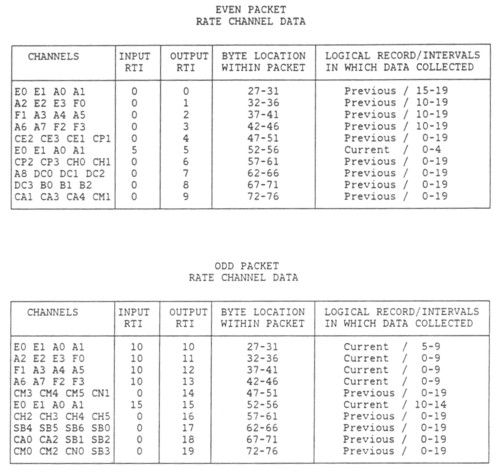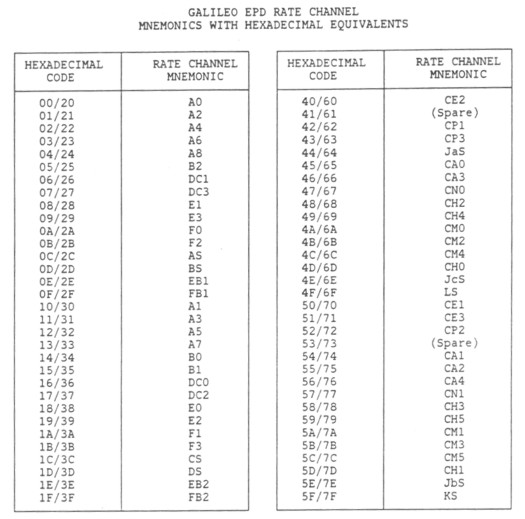The Galileo Energetic Particles Detector
Galileo EPD Handbook
Chapter 2. EPD Software
Energetic Particle Detector Experiment Flight Software System Documentation (continued)
Source: H. Malcom, July 30, 1982
5.0 RATE CHANNEL PROCESSING
A logical record contains data from consecutive even and odd packets. Each packet time is divided into ten real time interrupt intervals (numbered 0 - 9). A real time interrupt interval has a duration of 1/15 second so that one logical record occurs every 4/3 seconds. For the purpose of discussing the rate channel data, the twenty RTI's that comprise a logical record will be numbered 0 through 19.
There is a total of 62 rate channels of which 32 result from the detectors housed in the LEMMS telescope and 30 result from the detectors housed in the CMS telescope. Each of the rate channel accumulators is twenty-four bits wide and the contents of each are reported in the telemetry stream in a 10-bit log-compressed format. The data from groups of four accumulators are compressed and packed into 5 adjacent bytes within a telemetry packet. Table 5.2 shows the arrangement of the compressed rate channel data within the even and odd packets along with the time interval during which the data were gathered and the RTI in which the data were compressed and stored into the packet.
Each rate channel is identified by a unique mnemonic and by a corresponding hexadecimal code as shown in Table 5.3 As indicated by Table 5.2, four of the rate channels are reported four times during the logical record, twelve rate channels are reported twice per logical record and forty rate channels are reported only once per logical record. The rate channels that appear four times per logical record are read in RTIs 0, 5, 10, and 15; those that are reported twice per logical record are read during RTIs 0 and 10; and those that are reported once per logical record are all read during RTI 0. Thus a total of 80 rate channel values are reported in a logical record (40 in the even packet and 40 in the odd packet). The final 50 bytes (400 bits) of each packet contain 40 of the 10-bit log-compressed rate channel values.
Each odd TM packet includes 7 singles/background channels (SB0 - SB6) whose relationship to the rate channel accumulators is determined by the singles/background format. This format is defined by the settings of the singles/background (S/B) flag and the J/J' flag; see Table 5.1.
Table 5.1 Singles/Background Format
|
Flags |
Format |
Rate Channel Mnemonic |
|||||||
| S/B | J/J' | SB0 | SB1 | SB2 | SB3 | SB4 | SB5 | SB6 | |
| 0 | 0 | L | AS | BS | CS | DS | EB1 | EB2 | FB2 |
| 0 | 1 | L | AS | BS | CS | DS | EB1 | EB2 | FB2 |
| 1 | 0 | J | AS | LS | JaS | JcS | KS | JbS | FB1 |
| 1 | 1 | J' | AS | BS | Ja'S | Jc'S | K'S | EB2 | FB1 |
Note: The S/B and J/J flags are reported in bits 63 and 64 of each TM packet.
Table 5.2

Table 5.3

Return to EPD Flight Software System Documentation table of contents page.
Return to Galileo EPD Handbook Table of Contents Page.
Return to main
Galileo Table of Contents Page.
Return to Fundamental
Technologies Home Page.
Updated 8/23/19, Cameron Crane
QUICK FACTS
Mission Duration: Galileo was planned to have a mission duration of around 8 years, but was kept in operation for 13 years, 11 months, and 3 days, until it was destroyed in a controlled impact with Jupiter on September 21, 2003.
Destination: Galileo's destination was Jupiter and its moons, which it orbitted for 7 years, 9 months, and 13 days.



